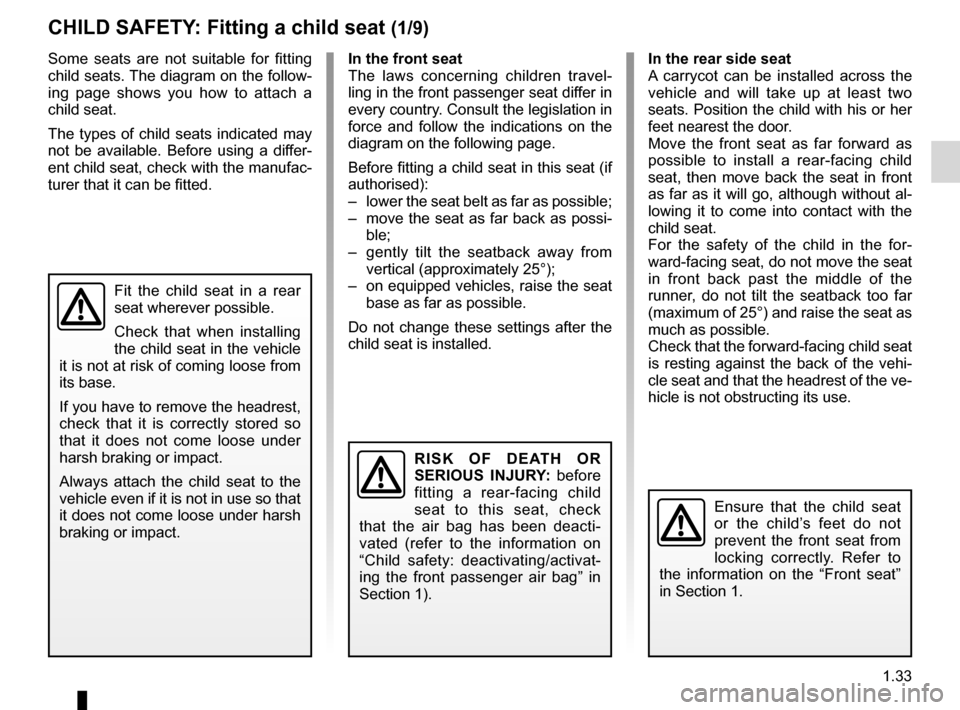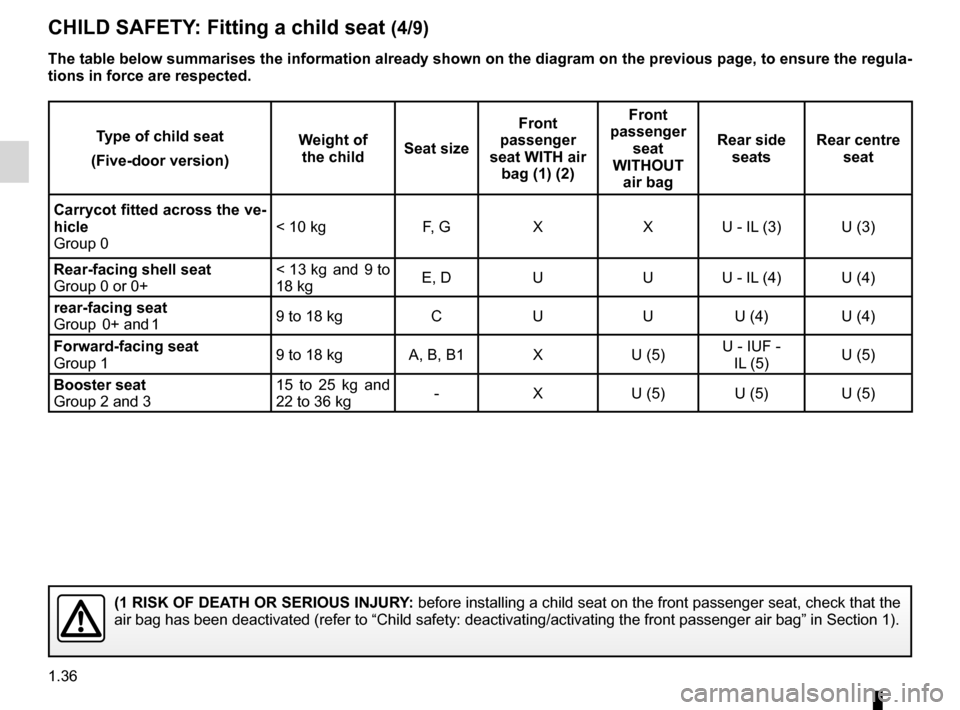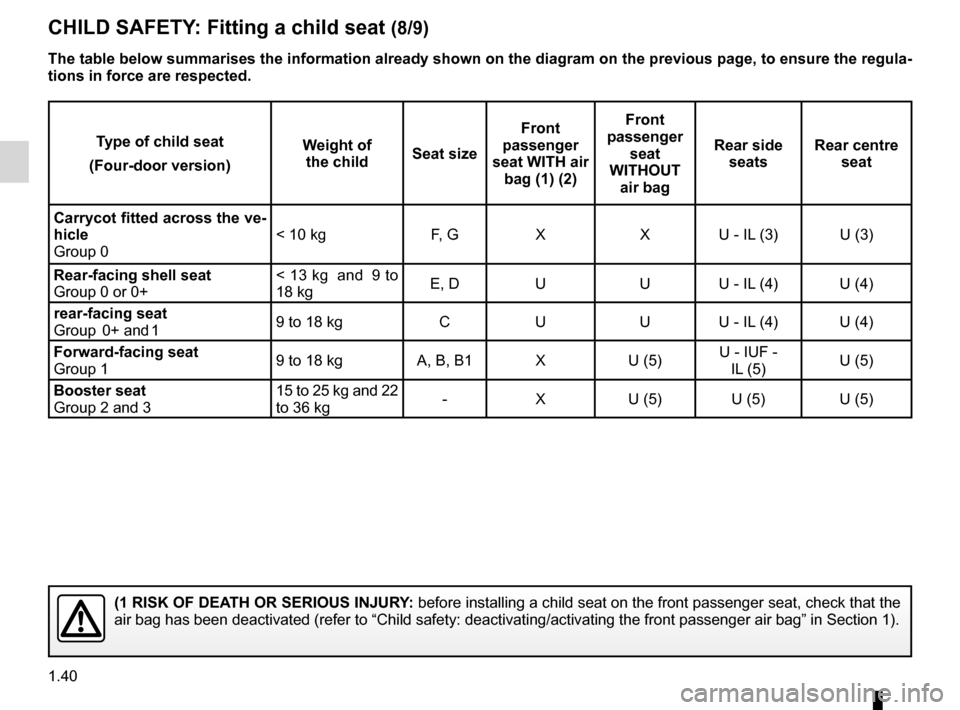diagram RENAULT FLUENCE 2012 1.G Owners Manual
[x] Cancel search | Manufacturer: RENAULT, Model Year: 2012, Model line: FLUENCE, Model: RENAULT FLUENCE 2012 1.GPages: 241, PDF Size: 6.5 MB
Page 37 of 241

child restraint/seat ................................ (up to the end of the DU)
child restraint/seat ................................ (up to the end of the DU)
child restraint/seat ................................ (up to the end of the DU)
child safety ............................................ (up to the end of the DU)
child seats ............................................. (up to the end of the DU)
transporting children ............................. (up to the end of the DU)
1.33
ENG_UD23757_3
Sécurité enfants : installation du siège enfant (L38 - X38 - R\
enault)
ENG_NU_891_892-7_L38-B32_Renault_1
Some seats are not suitable for fitting
child seats. The diagram on the follow -
ing page shows you how to attach a
child seat.
The types of child seats indicated may
not be available. Before using a differ-
ent child seat, check with the manufac-
turer that it can be fitted.
fitting a child seat
ChILD sAFETY : Fitting a child seat (1/9)
In the rear side seat
A carrycot can be installed across the
vehicle and will take up at least two
seats. Position the child with his or her
feet nearest the door.
Move the front seat as far forward as
possible to install a rear-facing child
seat, then move back the seat in front
as far as it will go, although without al-
lowing it to come into contact with the
child seat.
For the safety of the child in the for -
ward-facing seat, do not move the seat
in front back past the middle of the
runner, do not tilt the seatback too far
(maximum of 25°) and raise the seat as
much as possible.
Check that the forward-facing child seat
is resting against the back of the vehi-
cle seat and that the headrest of the ve-
hicle is not obstructing its use.
In the front seat
The laws concerning children travel
-
ling in the front passenger seat differ in
every country. Consult the legislation in
force and follow the indications on the
diagram on the following page.
Before fitting a child seat in this seat (if
authorised):
– lower the seat belt as far as possible;
– move the seat as far back as possi-
ble;
– gently tilt the seatback away from
vertical (approximately 25°);
– on equipped vehicles, raise the seat
base as far as possible.
Do not change these settings after the
child seat is installed.
R I sK O F D E AT h O R
s ERIOU s INJURY: before
fitting a rear-facing child
seat to this seat, check
that the air bag has been deacti -
vated (refer to the information on
“Child safety: deactivating/activat -
ing the front passenger air bag” in
Section 1).
Fit the child seat in a rear
seat wherever possible.
Check that when installing
the child seat in the vehicle
it is not at risk of coming loose from
its base.
If you have to remove the headrest,
check that it is correctly stored so
that it does not come loose under
harsh braking or impact.
Always attach the child seat to the
vehicle even if it is not in use so that
it does not come loose under harsh
braking or impact.
Ensure that the child seat
or the child’s feet do not
prevent the front seat from
locking correctly. Refer to
the information on the “Front seat”
in Section 1.
Page 40 of 241

1.36
ENG_UD23757_3
Sécurité enfants : installation du siège enfant (L38 - X38 - R\
enault)
ENG_NU_891_892-7_L38-B32_Renault_1
Jaune NoirNoir texte
The table below summarises the information already shown on the diagram on the previous page, to ensure the regula-
tions in force are respected.
Type of child seat
(Five-door version) Weight of
the child seat size Front
passenger
seat WITh air bag (1) (2) Front
passenger seat
WIThOUT air bag Rear side
seats Rear centre
seat
Carrycot fitted across the ve-
hicle
Group 0 < 10 kg
F, GXXU - IL (3) U (3)
Rear-facing shell seat
Group 0 or 0+ <
13 kg and 9 to
18 kg E, D
UUU - IL (4) U (4)
rear-facing seat
Group 0+ and 1 9 to 18 kg
CU UU (4) U (4)
Forward-facing seat
Group 1 9 to 18 kg
A, B, B1XU (5)U - IUF -
IL (5) U (5)
Booster seat
Group 2 and 3 15 to 25 kg and
22 to 36 kg
-
XU (5) U (5) U (5)
(1 RIsK OF DEATh OR sERIOUs INJURY: before installing a child seat on the front passenger seat, check that the
air bag has been deactivated (refer to “Child safety: deactivating/a\
ctivating the front passenger air bag” in Section 1).
ChILD sAFETY : Fitting a child seat (4/9)
Page 44 of 241

1.40
ENG_UD23757_3
Sécurité enfants : installation du siège enfant (L38 - X38 - R\
enault)
ENG_NU_891_892-7_L38-B32_Renault_1
Jaune NoirNoir texte
ChILD sAFETY : Fitting a child seat (8/9)
The table below summarises the information already shown on the diagram on the previous page, to ensure the regula-
tions in force are respected.
Type of child seat
(Four-door version) Weight of
the child seat size Front
passenger
seat WITh air bag (1) (2) Front
passenger seat
WIThOUT air bag Rear side
seats Rear centre
seat
Carrycot fitted across the ve-
hicle
Group 0 < 10 kg
F, GXXU - IL (3) U (3)
Rear-facing shell seat
Group 0 or 0+ <
13 kg and 9 to
18 kg E, D
UUU - IL (4) U (4)
rear-facing seat
Group 0+ and 1 9 to 18 kg
CU UU - IL (4) U (4)
Forward-facing seat
Group 1 9 to 18 kg
A, B, B1XU (5)U - IUF -
IL (5) U (5)
Booster seat
Group 2 and 3 15 to 25 kg and 22
to 36 kg
-
XU (5) U (5) U (5)
(1 RIsK OF DEATh OR sERIOUs INJURY: before installing a child seat on the front passenger seat, check that the
air bag has been deactivated (refer to “Child safety: deactivating/a\
ctivating the front passenger air bag” in Section 1).